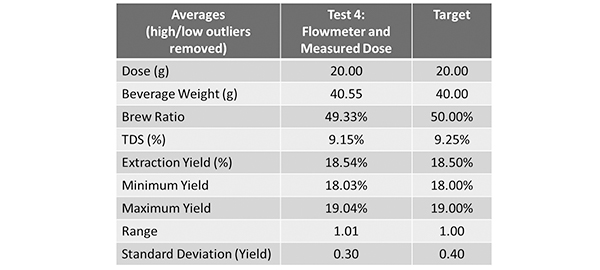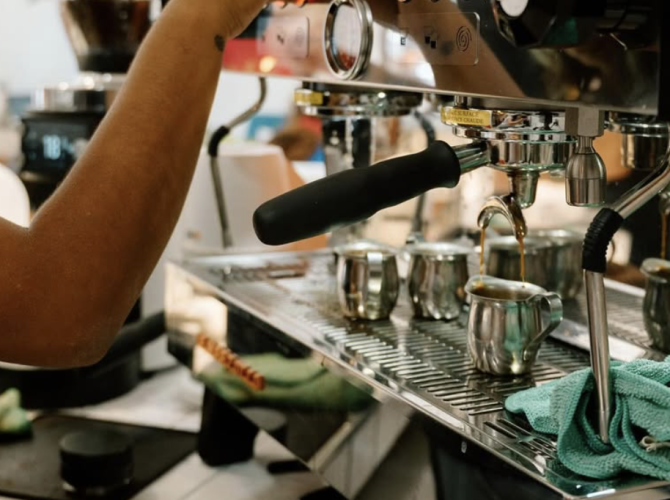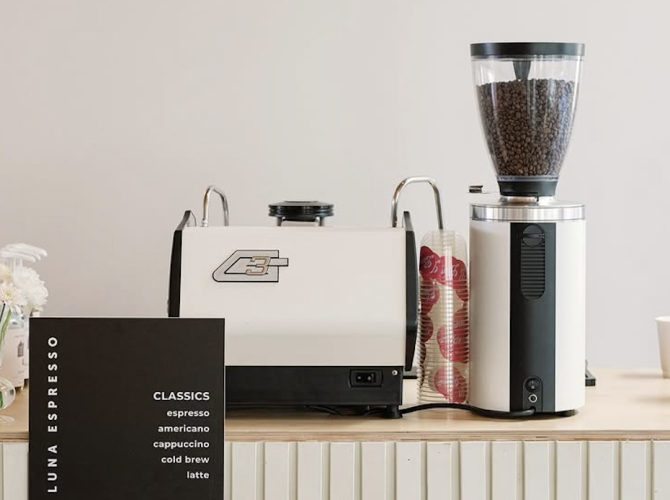Guest Blog Post, Ben Kaminsky
We recently invited Ben Kaminsky to team up with the La Marzocco USA Lab crew in Seattle to investigate volumetrics, and to see whether better consistency is achieved by having an experienced barista prepare espresso on a semi-automatic espresso machine, or if more consistent results are achieved through volumetrics.
The following is Ben’s write-up on the testing and the results.
It’s certainly no secret that in the business of specialty coffee (or really any business for that matter), consistency is king. Yet, for all our talk within the coffee industry of being consistent and using the best possible tools to achieve consistency in quality, how much do we actually do to enable baristas to be consistent?
Whether you choose to subscribe to the SCAA’s guidelines on extraction or not, one thing is for sure–whatever you do like, the goal is to repeat it over and over again in order to deliver the same coffee experience to each customer. That, in scientific terms, means repeating every extraction yield, on every espresso brewed and served, potentially hundreds of times in a day in rapid succession.
Some of you may have seen the video published by Matt Perger of St. Ali in Melbourne or previously read the words and recommendations of Scott Rao in the Professional Barista’s Handbook. Inspired by these works, we decided to do some simple testing of our own at La Marzocco USA, in Seattle.
 The testing was very straight-forward. Using a dose of approximately 20 grams of ground espresso in the portafilter1 2 3, and producing 40 grams of liquid espresso in the cup, we aimed to achieve a beverage strength of 9.25% total dissolved solids (TDS), with a resulting extraction yield of 18.5%4. The aim was to try to achieve an extraction yield that was within +-.5% of our target yield of 18.5%. (The minimum yield within the aim was 18% and the maximum 19%.)
The testing was very straight-forward. Using a dose of approximately 20 grams of ground espresso in the portafilter1 2 3, and producing 40 grams of liquid espresso in the cup, we aimed to achieve a beverage strength of 9.25% total dissolved solids (TDS), with a resulting extraction yield of 18.5%4. The aim was to try to achieve an extraction yield that was within +-.5% of our target yield of 18.5%. (The minimum yield within the aim was 18% and the maximum 19%.)
Next, we conducted four tests:
Test one allowed for the barista to use only one set time. In this test, the barista dialed in to achieve a beverage weight of 40 grams and a yield of 18.5% in 28 seconds. Once the test began, the barista continued pulling shots exclusively at 28 seconds. “Normal”5 bar-style dosing conditions were applied in this test, and also in tests two and three.
Test two allowed for the barista to use both time and sight (visual appearance of espresso in a shot glass) to dictate when they would stop their extraction. Today, many La Marzocco USA customers train their wholesale customers to prepare espresso using this method.
Test three utilized volumetric flowmeters6, again with “normal” dosing conditions (the barista dosed the coffee going into the portafilter with a combination of grinder dose and a controlled leveling process).
Test four utilized volumetric flowmeters with a coffee dose that was controlled within a tenth (0.1) of one gram for every extraction, using a scale to weigh the portafilter prior to brewing.
Prior to each of the four tests, our barista adjusted grind and time of extraction in order to achieve an 18.5% extraction yield, using a scale for dose to 20.0 grams and separate scale for beverage weight of 40 grams.
The data was staggeringly decisive. Let’s take a look…
Test Results & Analysis
For each test, the highest and lowest outliers were removed.
Test one results & analysis
In the first test, using only time as a metric, the barista fell outside the aim in every category: beverage weight, brew ratio, TDS, and extraction yield. Not surprising, really, given even the tiniest of variances in dose, we see that consistency was completely lost when relying only on time as a metric.

Test two results & analysis
At a glance, the Sight and Time test (test two) produced intriguing results. The average extraction (18.30%) falls within the target range (18.00-19.00%), but only as a technicality of the average. Looking further at the results, it’s clear that the minimum and maximum extractions were in-fact well outside of the aim. A standard deviation of 0.52 tells us that the shot-to-shot variance was pretty enormous.

Test three results & analysis
The third test used the flowmeter, with the barista dosing the coffee by grooming out of the portafilter. This category performed reasonably well, falling within the aims of extraction and minimum extraction, though even after the outliers were removed there remained some high-yielding extractions that fell outside of the target 19.00% maximum. Note here that even with a varying dose, the brew ratio remained very close to our target of 50%.

Test four results & analysis
Comparatively, test 4 demonstrates astounding consistency in all aspects, beating, or falling nearly dead-on the target. Extraction yield (18.54%) and minimum yield (18.03%) both beat the aim (18.00%). The maximum yield is 19.04% – just .04 beyond the target maximum. The range is just .01 above the target. The standard deviation (0.30) really says it all in this round, essentially decimating the others from a statistical perspective and beating the target by a full tenth (0.40).

Conclusions
There are a number of additional factors to consider. One key element at play here not shown in the data set, that really shouldn’t be underestimated, is speed.
In practical application, in a bar setting, baristas utilizing flowmeters are nearly 50% faster than those pulling shots without. Baristas not utilizing volumetric measurement are essentially forced to watch the entire duration of the espresso extraction in anticipation of its conclusion. For most shops, that means about 25-30 seconds where someone is being paid to watch espresso pour into a cup. While some shops employ multiple baristas to enable a better, faster workflow and more skilled baristas are generally able to handle some additional multitasking, I can tell you from all my experience traveling to espresso bars around the world, I have never seen a faster workflow, while surpassing my personal expectations for consistency, than one employing volumetric flowmeters.
On average from data that I’ve collected empirically as well as in this testing, for drink preparation alone, I would argue most specialty coffee bars run between 40-70 seconds per espresso drink in the queue; a wide margin, but one that the vast majority fall in… A very fast bar would get that number down to between 30-40 seconds. Using two baristas, timed grinders, and a volumetric machine with multiple groups, I’ve seen as fast as nearly 20 seconds per customer per drink. This enabled a very small cafe I visited to do an admirable and otherwise impossible number of drinks per hour.
The performance of the flowmeter does, of course, degrade over time. All parts eventually fail and need to be maintained or replaced, especially those in constant contact with water. In all likelihood, you live in a place that has water that is softer or harder than is ideal for the performance of the espresso machine, the flowmeter, and the flavor and extraction of the coffee.
Generally, near-ideal water has approximately between 65-85ppm in CaCO3 as a subset of total water hardness. That translates to between 4-5 grains per gallon if you’re in the United States, and just about the same number of German degrees hardness if you’re anywhere else7. This is definitely something to keep in mind when using a volumetric espresso machine, as hard, untreated water will rapidly degrade the performance of a flowmeter by formation of scale within the system.
Over the last four years, as coffee professionals have started to take a serious look at espresso measurement, I can’t help but think of all the conversations I’ve had in which someone inevitably said, “If you could pull every espresso within a gram, you’d probably have the most consistent espresso bar in the world.” I wholeheartedly believe this is actually true. Flowmeters absolutely prove themselves to be a reliable tool to help move in that direction.
You can review the raw data from the four tests here; I’ve also included a graph of each shot measured in the data set for those of you who are keen to dig deeper. I sincerely recommend it.
-Ben Kaminsky
1. We employed a 20g ridgeless VST basket for the purpose of this testing. This is also the WBC spec portafilter basket. We also used a 58.4mm flat tamper.
2. We allowed for some variation in dose to mimic that of “real-world” conditions.
3. Ground coffee was groomed once out of the portafilter to try and maintain accuracy and consistency in dose.
4. All shots were measured using a VST Lab II refractometer and syringe filtered for clarification.
5. “Normal” for the sake of the test is defined as a groomed dose out of a Mazzer Robur E timer-based espresso grinder. The target ground coffee dose was 20g for every shot pulled.
6. The flowmeter is a paddlewheel-like device that measures the volume of water passing from the coffee boiler to the coffee cake.
7. 1 grain/US gallon = 0.958 German degrees = 1.71 French degrees.





